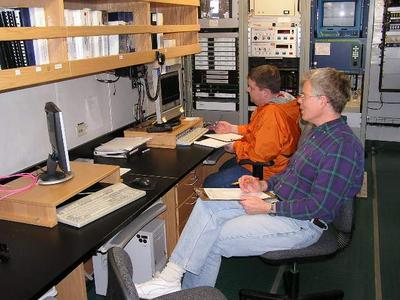14 July, 2003
So how about the CTDs of oceanography?
CTD is the name of the instrument that measures the Conductivity,
Temperature, and Depth (or more accurately pressure) of the sea-water
that we are studying. The CTD sensor is mounted to the rosette water
sampler and lowered through the water while continuously measuring
various properties of the water. This information is instantly
transmitted through an electronic cable to the surface which gives
the scientists a read-out of the water's characteristics. This
allows them to distinguish various boundaries within the water
column and helps the scientists determine the depths that the water
bottles on the rosette will open and sample from.
Some of the characteristics that the scientists use from the CTD are
salinity (saltiness), temperature (near freezing here), oxygen
(dissolved in the water), chlorophyll (the phytoplankton or "green
bugs and plants"), and transmissivity (parcticles, or in a sense,
water clarity). Even to a non-oceanographer such as me, it's pretty
exciting watching the read-outs as the CTD descends from the surface
and creates a profile of the water structure or layers. The
resulting display shows where the maximums and minimums of
each property occur, and demonstrate just how non-homogeneous the
sea-water is from top to bottom.
Over the last couple of days, for example, we have been observing
very low salinities near the surface. Jim Swift, the Chief
Scientist, speculates that this may be water from the outlet of the
Mackenzie River which is located in Canada to the east of our present
position. The chlorophyll maximum occurs around the 25 meter mark.
This may indicate a boundary layer of nutrients utilized by the
phytoplankton. Below that the temperature and oxygen data show
layers of water that originate from the Chukchi Sea and the Atlantic
Ocean. And very deep is water that may be over 700 years old which
some believe represents a relic from the Little Ice Age.
It's no wonder then that our project's name is the Collaborative
Research: CTD/Hydrographic and Underway Service Measurements for the
Shelf-Basin Interactions Phase II Field Project.

Raytheon technician Jenny White readies the next CTD cast.

Jim Swift and Jeremy Mathis monitor a CTD/rosette cast.

The CTD sensor attached to the bottom of the rosette water sampler.
Contact the TEA in the field at
.
If you cannot connect through your browser, copy the
TEA's e-mail address in the "To:" line of
your favorite e-mail package.
|
